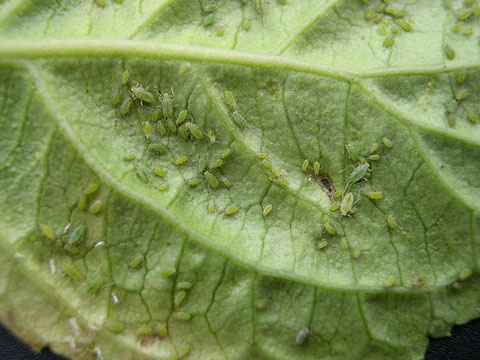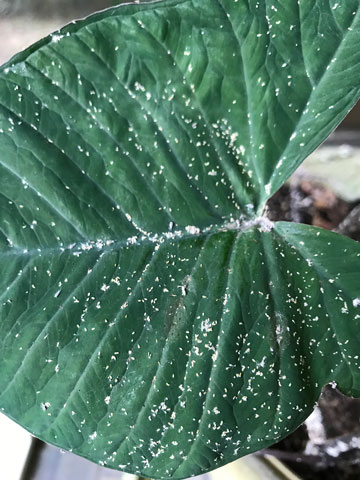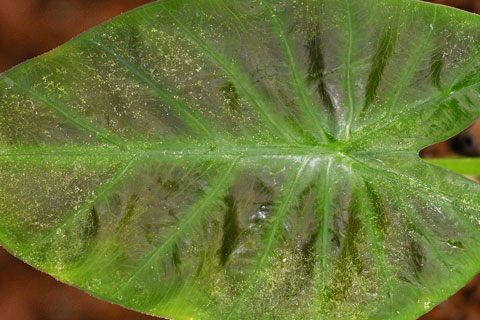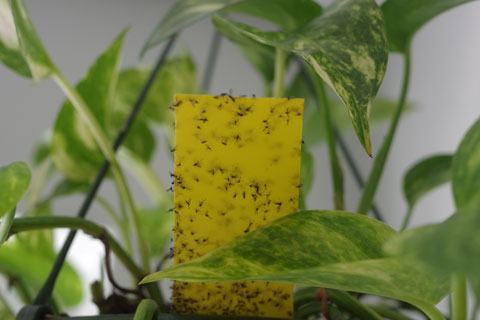10/1/2022
Common Insect Problems on Tropical Houseplants
Dr. Aaron Palmateer

Many houseplants have tropical or subtropical origins and include foliage plants, orchids and other flowering plants, palms, succulents and cacti. Unfortunately, the environment where most of these plants thrive is very conducive to plant pests. Keep in mind that many pests are attracted to stressed plants and healthy plants are less likely to have problems. The key to success is to start with clean plants and to create an environment for them to thrive.
Pictured: Aphids on a hydrangea.
Aphids
Aphids are among the most common insect pests. Many species of aphids feed on ornamental nursery and greenhouse crops. Primary aphid pests found on houseplants include the green peach and melon aphids. Aphids have tremendous reproductive potential, and large populations can cause significant damage and reduce plant quality. Different species feed on different areas of a plant. Some prefer foliage, others feed on petioles and branches, and some like flowers, fruit or roots.
Aphids are typically found clustering on shoots and leaves of young succulents, although some species occur on flowers, branches and/or roots. Most adult aphids are about an eighth of an inch long, pear-shaped and can vary widely in color from green to yellow, pink or black. They’re soft-bodied insects and often possess a pair of hornlike structures known as cornicles at the posterior end of the abdomen. Winged aphids hold their wings vertically above the body when at rest.
Feeding aphids often cause new growth to become deformed where the leaves twist and curl, which could be mistaken as herbicide damage. Severe infestations can result in wilting and even plant death. One highly visible sign of aphids feeding on plants is the production of honeydew and subsequent presence of sooty mold fungi, as well as ants. Sooty mold fungi typically appear dark brown to black in color and aren’t plant pathogens, but feed on the honeydew excreted by the aphids. The presence of sooty mold fungi gives a dirty appearance to affected plants and reduces photosynthesis, thus negatively impacting plant quality. Further, ants will act to protect the aphids from predaceous and beneficial insects, as the honeydew is their food source.

Scale (including mealybugs)
Scale insects, including mealybugs, are members of the Homoptera order. Scale insects come in several forms: There are soft scales (Coccidae), armored scales (Diaspididae) and mealybugs (Pseudococcidae). These insects are notorious for attacking all types of tropical foliage plants, which includes houseplants. It’s critical for growers to consider that anytime they accept new plant material, there’s the potential for introducing pests. It makes no difference the time of year (when plants are in greenhouses) or where the operation is located, as most of these pests are capable of surviving for several weeks even without a host. Thus, if the plants survive the trip, it’s highly likely the scale insects will, too.
Pictured: Mealybugs on an upper leaf of an alocasia.
Scale insects are difficult to detect and even more difficult to control. Once the young crawler stage becomes established on the plant, they may no longer move or move so slowly that they appear dead. They could even be confused as part of the plant. They’re often located in hard-to-see areas such as roots, lower stems below the canopy, the underside of leaves or branches where they remain hiding in the nooks and crannies. Thus, light infestations can easily be overlooked, allowing the population to build to damaging levels before detection is finally made.
Scale insects feed by inserting mouthparts into plant tissue and sucking out sap. There may be no symptoms when just a few individuals or a small population are present, but larger populations can cause plant stunting, the leaves may develop yellow spots, branches often die back and sometimes plants completely defoliate.
Most mealybugs have a protective covering composed of waxy secretions that form a dense mat of wax filaments or fuzz, which makes them difficult to control with pesticides that work on contact. Common examples include the longtailed mealybug (Pseudococcus longispinus) with characteristically long waxy filaments that protrude from the end of the abdomen. The most common is the citrus mealybug (Planococcus citri), which lacks any waxy filaments and has a gray stripe that extends the length of the body. Citrus mealybug is reported to lay up to 500 eggs contained in irregular cottony masses.
Another type of mealybug are Rhizoecus species that are among the most difficult to control because they attack and feed on roots. These mealybugs typically appear powdery and white, as the nymphs are covered by a white waxy material. High populations of these mealybugs feeding on roots cause plants to turn yellow and become stunted.
Plants infested with root mealybugs that go unnoticed can serve as a source for further spread to healthy plants. These mealybugs easily move with water through drain holes in pots and then crawl into adjacent potted plants where they become further established on the roots.
Other mealybugs recently introduced into ornamental production within the U.S. include the Mexican mealybug (Phenacoccus gossypii), the Madeira mealybug (Phenacoccus madeirensis) and the pink hibiscus mealybug (Maconellicoccus hirsutus).

Mites
Thousands of mite species feed on and cause damage to houseplants. Although mites are often grouped with insects, they’re arachnids and more closely related to ticks and spiders. Adult mites have eight legs and piercing/sucking mouthparts used to suck fluids from host plants. In addition to direct damage, mites are capable of transmitting plant viruses, making mite management critical in commercial production settings. The most common mites that attack houseplants are spider mites.
Pictured: Spider mite damage on a colocasia leaf.
Most mites are tiny and require a hand lens to be seen, making them difficult to detect in the absence of symptoms. Some mites, particularly Eriophyid mites, are so small they require a microscope to be seen. Immature mites in the larvae stage have only six legs. The exception is Eriophyid mites, which have four legs in all stages of development.
Most mites favor hot and dry conditions, and are capable of multiplying rapidly with generations occurring within one week. Nearly all plant species have at least one species of mite that will feed on them. Mites can be introduced on infested plant material, but often, they’re introduced into production facilities by the wind. Most mites damage plants by sucking cell contents from leaf tissue. The initial feeding damage appears as a series of tiny dots on the surface of affected leaves. Heavily infested leaves and branches may be covered in fine silken webbing (i.e., spider mites), but webbing may be minimal on some plants, such as conifers, or completely absent on some species. Severely affected leaves turn bronze to yellow in color and eventually drop off the plant.
Whiteflies
Whiteflies are tiny, sap-sucking insects that can be major pests of houseplants. They’re most common during periods of warm to hot weather and can build up to extremely high populations on susceptible plants in greenhouses and nurseries. When actively feeding, whiteflies cause leaves to turn yellow and eventually brown as the leaf tissue dies. Large colonies typically develop on the undersides of leaves where they normally lay tiny oblong eggs that range from yellow to white in color. After the eggs hatch, the young whiteflies go through four nymphal stages called instars. Winged adults emerge from the last nymphal stage. All stages feed by sucking plant juices from leaves and excrete excess liquid as drops of honeydew when they feed.
There are numerous species of whitefly associated with houseplants. The most common species include the greenhouse whitefly (Trialeurodes vaporariorum) and the sweet potato whitefly (Bemisia tabaci), and both have a wide range of plant hosts that includes many agronomic crops and weeds. Areas with warmer climates including indoor environments provide opportunity for these pests to breed year-round. In addition to the destructive feeding damage whiteflies cause on plants, the honeydew excreted on the affected leaves provides a source of nutrition for sooty mold fungi.

Fungus gnats
Although fungus gnats have a wide host range, they can be a nuisance to people and can be mistaken for mosquitoes. Fungus gnats are small flies that develop in the growing medium of houseplants. The larvae feed on algae, fungi and plant roots, but the adults do not feed or bite.
Fungus gnat larvae are typically found within the top few inches of growing media, especially under wet conditions. Fungus gnat adults are highly attracted to moist growing media, so watering practices should account for changes in temperature and daylength, such as fall and winter months when plant growth and water usage slows down.
Pictured: Fungus gnats on a sticky card.
Thrips
In general, thrips aren’t the most common pest found on houseplants, except for those plants in flower (i.e., orchids). However, there are species that feed readily on foliage and can be problematic. Lower and upper leaves can become discolored between the lateral veins, and damaged leaf tissue often appears bronze-like in color or even looks bleached. Feeding can result in leaf distortion and black spots, or excrement may be visible on plant leaves. Large populations can cause extensive plant damage in short periods of time.
Effective pest management requires a preventative approach. Many plant pests are excellent opportunists and are more likely to become an issue on stressed plants. This is especially true when plants are relocated via shipping or being repotted. Identify and closely monitor plants known to host high populations because infestations will likely start on the most susceptible plants.
Frequent inspection of plant material is essential to prevent rapid buildup. This includes thorough inspection of new plant material, so that issues can be addressed from the start. Many weeds are hosts for pests and should be removed or controlled with herbicides. GT
Dr. Aaron Palmateer has been providing technical support for growers in the horticultural industry, most recently for SePRO Corporation.